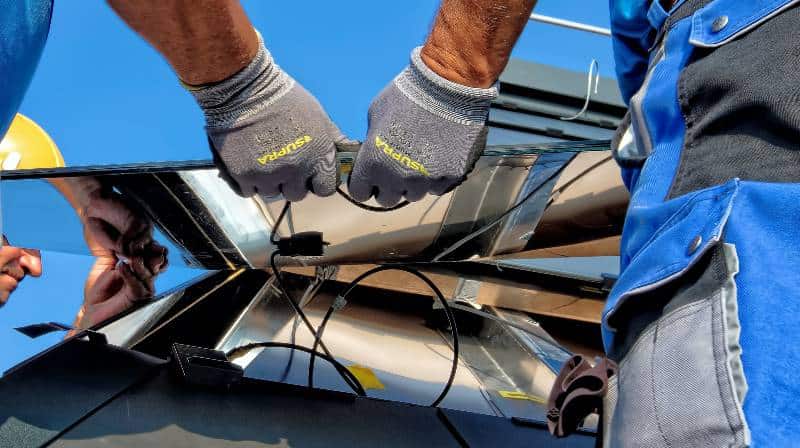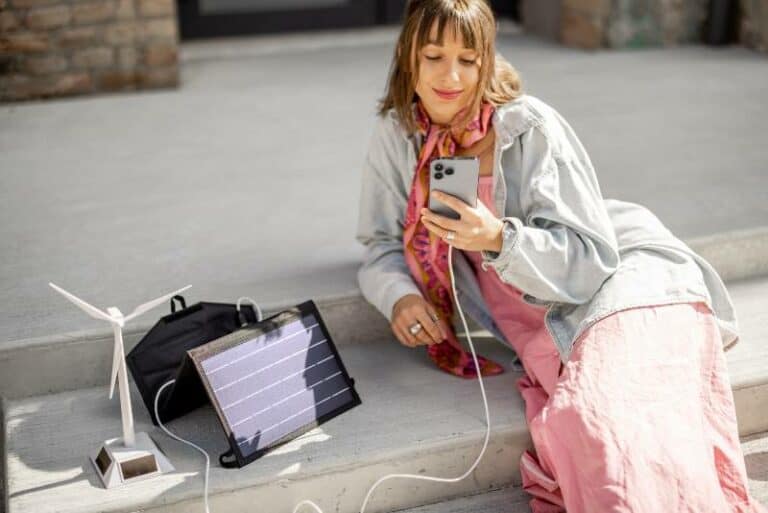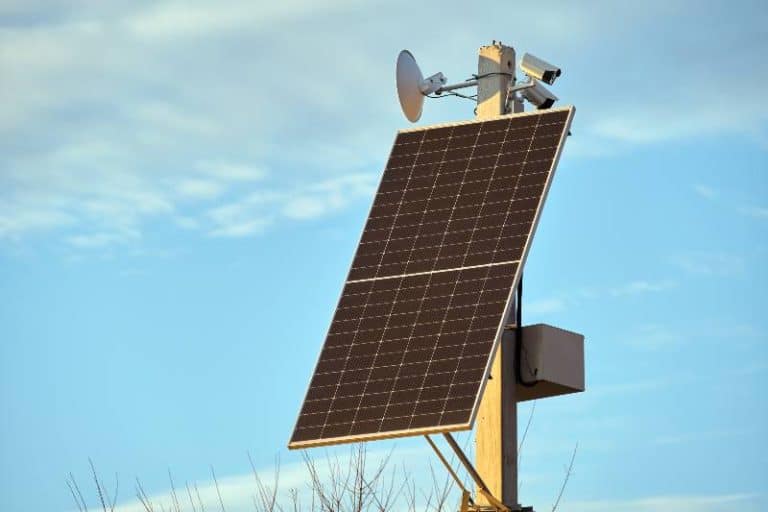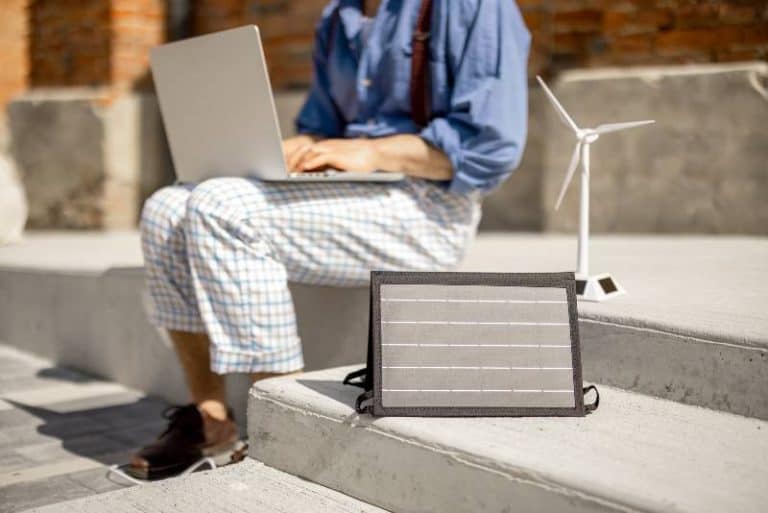The Power Behind Solar Generators: Understanding Inverters
Have you experienced a power outage and are you considering investing in a solar generator but aren’t sure what to look for? A key component of any solar generator is the inverter, and it’s important to understand its role in your system. In this blog post, we’ll explore the purpose and benefits of using an inverter in a solar generator. We’ll also discuss how to identify quality inverters versus those that may be prone to failure. By getting familiar with these components ahead of time, you can make better-informed decisions about which power solutions are right for you. Let’s dive in!
The inverter is a crucial component of a solar energy system as it converts the direct current (DC) electricity generated by solar panels to alternating current (AC) electricity that the electrical grid can use.
Key Takeaways
- Inverters play a pivotal role in solar generators by converting direct current (DC) into alternating current (AC), which is essential for powering most devices. The type and efficiency of the inverter significantly impact the power output of the generator.
- There are various types of inverters, including string inverters, microinverters, and power optimizers. Each has its own strengths and weaknesses, and the choice of inverter should be based on specific needs and circumstances.
- To maximize the power output and efficiency of a solar generator, it’s critical to understand the role of inverters and consider factors such as efficiency, cost-effectiveness, and the specific needs of your solar setup when selecting an inverter.

Understanding Solar Inverters
A solar inverter, often referred to as a PV (photovoltaic) inverter, is a critical component in a solar power system. It plays an essential role in converting the variable direct current (DC) output of a photovoltaic solar panel into a utility frequency alternating current (AC) that can be fed into a commercial electrical grid or used by a local, off-grid electrical network. To simplify, the solar inverter is essentially the heart of any solar powered generators and system because it facilitates the actual use of the energy generated by portable solar panels.
The primary function of a solar inverter is to convert DC electricity from solar panels into AC electricity. Solar panels absorb sunlight and through the photovoltaic effect, they generate DC electricity. This electricity is sent to the inverter, which transforms it into AC electricity, the type that is used by the majority of home appliances and electrical systems. This DC to AC conversion is critical because without it, the energy generated by the solar panels would be unusable in a typical home or business setting.
Additionally, solar inverters manage the voltage level that comes out of the solar panels to ensure it matches the voltage of the electrical grid or the appliances being powered. This is crucial because different appliances require different voltages, and matching these voltages ensures that the appliances can function properly and safely.
Solar inverters also have a role in maximizing the efficiency of the solar system. This is done through a process called maximum power point tracking (MPPT). MPPT is a technology that solar inverters use to extract the maximum possible power from a solar panel during varying conditions, such as changes in temperature and sunlight levels.
To understand how solar inverters work, let’s think of a simple analogy. Imagine you have a group of musicians (the solar panels) who can play beautiful music, but all play at different tempos and in different keys. The solar inverter is the conductor, who takes this discordant music and brings it into harmony so that it can be enjoyed by everyone (the electrical grid or your home appliances). Just as the conductor enables the musicians to create a harmonious and beautiful symphony, the solar inverter allows the solar panels to efficiently and safely provide usable power.
Now, let’s delve a little deeper into the working principle of a solar inverter. The operation of the solar inverter is based on the fundamental principle of electromagnetic induction, which was discovered by Michael Faraday. Faraday’s law of electromagnetic induction states that a change in the magnetic field within a closed loop of wire induces an electromotive force (EMF) in the wire.
In the case of a solar inverter, the process starts when the photovoltaic cells in the solar panels absorb sunlight and generate DC electricity. This DC electricity is fed into the solar inverter, and therein, it enters a component known as the transformer. The transformer comprises a closed loop of wire (usually copper) that’s wound around an iron core.
When the DC electricity, which has a constant magnetic field, is switched on and off rapidly (usually by a component called a switch-mode power supply), it creates a changing magnetic field within the transformer.
According to Faraday’s law, this changing magnetic field induces an electromotive force (or voltage) in the wire. However, because the DC electricity is being switched on and off, the voltage that’s induced alternates between positive and negative values, creating alternating current (AC).
Thus, through the fundamental principle of electromagnetic induction, the solar inverter successfully transforms the DC electricity from the solar panels into the AC electricity that powers homes and businesses.
Different Types of Solar Inverters
Each type has its own unique features, benefits, and considerations, and the choice between them often depends on the specific circumstances of the solar installation.
1. String Inverters: String inverters are the most common and traditionally used type of inverter in residential and commercial solar installations. They’re named so because they work with a series, or a “string” of solar panels linked together. In a typical setup, solar panels are connected in a series circuit to form a ‘string’, and multiple strings can be connected to a single string inverter.
The function of the string inverter is to convert the total DC output from all panels in that string into AC power. It’s important to note that string inverters manage the entire string as one unit. As such, if one panel in the string underperforms due to shading, dirt, or malfunction, the output of the entire string drops to match the underperforming panel.
Consider this analogy: a string inverter functions like a team coach who trains the team as a whole. If one player (panel) underperforms, it can affect the performance of the entire team (string of panels). String inverters are generally cost-effective and have a proven track record of reliability, making them a good choice for solar installations without shading issues and where all panels have similar exposure to sunlight.
2. Microinverters: Unlike string inverters, which operate at the string level, microinverters operate at the individual solar panel level. In a microinverter system, each solar panel has its own small inverter attached to it, hence the prefix ‘micro’.
Each microinverter converts the DC power to AC power right at the panel site. This means the performance of each solar panel is individually optimized and not affected by the performance of other panels in the array. This can be particularly beneficial in installations where panels face different directions or have different tilts, or where shading is a concern.
Imagine a class where each student has their own personal tutor. These tutors are like microinverters. They allow each student (solar panel) to learn and perform at their own pace, unaffected by how the others are doing. However, the overall system cost can be higher with microinverters, and each one being an electronic device is subjected to wear and tear and potential failure.
3. Power Optimizers: Power optimizers, often also known as DC optimizers, represent a middle ground between string inverters and microinverters. Like microinverters, power optimizers are also attached to individual solar panels. However, rather than converting DC to AC power at the panel, power optimizers ‘condition’ the DC power (by adjusting voltage and current) before sending it to a centralized string inverter which then completes the DC to AC conversion.
Essentially, power optimizers combine the benefits of microinverters (individual panel-level optimization) with the simplicity and reliability of string inverters. They can improve the overall system efficiency, especially in situations where there are shading issues or the panels are in different orientations.
Returning to the classroom analogy, power optimizers are like giving each student a customized study guide (optimized DC power) but still having a central teacher (the string inverter) who conducts the class (converts DC power to AC power). This can be an attractive option because while power optimizers add some cost to the system, they’re typically less expensive than microinverters, and they improve the efficiency of the system without adding the complexity of having multiple inverters.
How Inverters Impact Power Output
The efficiency and technological sophistication of a solar inverter can significantly affect the total power production of a solar energy system.
Inverter efficiency is a critical factor to consider as it directly impacts the amount of AC power that ends up being usable from the total DC power produced by the solar panels. In essence, inverter efficiency is the ratio of the output power (AC power) to the input power (DC power). For instance, if your solar panels are generating 1000 watts of DC power, and after conversion, you’re getting 970 watts of AC power, then the inverter’s efficiency is 97%.
The difference between the DC power produced by the solar panels and the AC power available for use is due to the energy losses that occur during the conversion process. These losses can be attributed to factors such as heat dissipation, electrical resistance, and the operational requirements of the inverter itself. It’s worth mentioning that no inverter is 100% efficient due to these inherent energy losses, but most modern inverters typically operate at efficiencies of around 95-99%.
To put it into perspective, consider the solar inverter as a currency exchange booth. Suppose you are converting 100 dollars into euros, and the booth charges a small fee for the service. If the fee is 3 dollars, you’ll end up with the equivalent of 97 dollars in euros. The efficiency of the exchange booth (the solar inverter) is 97%, because you can use 97% of your initial money (the solar energy) after the conversion process.
Beyond mere efficiency, the technology that the inverter uses can also play a significant role in maximizing power production. Let’s focus on two key aspects of inverter technology: Maximum Power Point Tracking (MPPT) and inverter type.
1. Maximum Power Point Tracking (MPPT): This is a feature that’s built into many modern inverters and plays an important role in maximizing power output. Essentially, MPPT algorithms allow the inverter to adjust the electrical load drawn from the solar panels to find the maximum power point – that is, the point at which the panels’ voltage and current result in the most power output. This allows the solar energy system to produce the maximum possible power even under varying sunlight and temperature conditions.
2. Inverter Type: As discussed previously, the type of inverter – string inverter, microinverter, or power optimizer – can also affect the power output. String inverters, while cost-effective and reliable, may not fully optimize power output if there’s shading or the panels are oriented differently.
Microinverters and power optimizers, on the other hand, can enhance power output by managing each panel individually. They ensure that a poorly performing panel doesn’t affect the output of the entire string or system. This can lead to an overall increase in power output, especially in installations with varied orientations or partial shading.
The efficiency and technological features of solar inverters can significantly impact the power output of a solar energy system. A high-efficiency inverter equipped with advanced technology like MPPT, and chosen wisely according to the installation circumstances, can help maximize the overall power production and make the solar system more effective and beneficial.
Importance of Choosing the Right Inverter
There are several factors to consider when choosing an inverter for your solar generator, and making the right choice can maximize the return on your solar investment.
1. Size of the System: The size (in terms of power capacity) of your solar power system is one of the most crucial factors to consider. The inverter must be able to handle the maximum power that your solar panels can generate. If you choose an inverter that is too small, it will not be able to convert all the power produced by your solar panels, leading to energy wastage. On the other hand, an excessively large inverter might not operate as efficiently at low power levels and could result in a less economical solution.
2. Efficiency: As discussed earlier, the efficiency of a solar inverter is a measure of how much of the input DC power from the solar panels is converted into AC power for use. High-efficiency inverters ensure that more of the power produced by your solar panels is available for use, increasing the overall effectiveness of your solar power system.
3. Reliability and Warranty: Solar inverters are typically the part of the solar system most likely to encounter issues over time. It’s, therefore, crucial to choose an inverter from a reputable manufacturer offering a solid warranty. The warranty should ideally cover the inverter for a significant portion of the solar power system’s expected life, typically around 10 to 15 years.
4. Features and Capabilities: Modern inverters often come with advanced features such as data monitoring systems, which allow you to track the performance of your solar panels and inverter. In addition, if you’re considering a battery storage system, you may want an inverter capable of managing the battery’s charge and discharge. Some inverters also have features like Wi-Fi connectivity and compatibility with home energy management systems.
5. Installation Conditions: If your solar panels are partially shaded at times, or face different directions, microinverters or power optimizers would likely perform better than a standard string inverter. The physical installation location of the inverter is also important, as some inverters are designed for indoor installation while others are rated for outdoor installation.
6. Grid-Connected or Off-Grid: If your solar generator is going to be connected to the electrical grid, you will need a grid-tie inverter that can synchronize with the grid’s AC current. On the other hand, if your solar generator is entirely off-grid, you will need an off-grid inverter, possibly with built-in battery management capabilities. Some inverters, known as hybrid inverters, can work both on-grid and off-grid.
7. Local Grid Regulations and Standards: Depending on where you live, there may be specific requirements or standards that the inverter must meet to connect to the local electricity grid. This can include safety features like anti-islanding (which shuts down the solar system when the grid is down), specific performance standards, or certification requirements.
By carefully considering all these factors, you can choose the right inverter for your solar generator that not only optimizes the power output and efficiency but also ensures a smooth, reliable operation over the system’s lifetime. It’s always advisable to engage with a solar power professional who can guide you through the selection process based on your specific circumstances and requirements.
Make sure to take the time to read this enlightening article about Solar Power On-the-Go: Portable Solar Panels for Work. Discover how these innovative and convenient portable solar panels can harness the power of the sun to provide sustainable energy solutions while you’re on the move. Don’t miss out on this fascinating exploration of how solar technology is revolutionizing the way we work and power our devices!
Case Study: Inverters and their Impact on power output
Let’s imagine a medium-sized office building in Sacramento, California, that decided to go solar to reduce its environmental footprint and electricity costs. They installed a 100 kW solar power system, comprising of 250 solar panels, each with a capacity of 400W.
Given the absence of shading issues and uniform alignment of panels, the initial installation used a high-quality string inverter with a rated efficiency of 98%. The system performed well, but after closely monitoring the power output, the energy manager noticed that the building’s power output was slightly lower than the expected output, particularly during the early mornings and late afternoons.
After analyzing the situation, the energy manager realized that even though the panels were mostly unshaded, some panels were underperforming during certain times due to the building’s architecture. These underperforming panels, tied to the same string of panels as the high-performing ones, were causing the entire string’s output to decrease due to the nature of the string inverter.
To address this issue, the management decided to replace the string inverter with microinverters for each panel. After the installation of microinverters, they observed a significant improvement in the system’s overall power output. The panels that were underperforming earlier due to temporary shading no longer pulled down the performance of the entire string. Instead, every panel operated at its maximum potential, regardless of how the other panels were performing.
By the end of the year, the switch from a string inverter to microinverters resulted in an increase in power output by around 10%, providing the office building with additional savings on their energy bills.
This case study demonstrates how important it is to choose the right type of inverter for your specific conditions and needs. While string inverters can be very efficient and cost-effective for many installations, microinverters can provide significant benefits in situations where shading or other factors may cause some panels to underperform. It underscores the fact that inverters, beyond their basic function of converting DC power to AC power, can have a substantial impact on the overall power output of a solar energy system.

Inverters in Solar Generators FAQs
What factors should I consider when choosing an inverter for my solar generator?
When selecting an inverter for a solar generator, it’s important to consider factors such as efficiency, reliability and warranty, features and capabilities, installation conditions, grid connectivity or off-grid status, and local grid regulations and standards.
What is the role of inverter technology in maximizing power production?
Inverters have an important role to play in maximizing power production from a solar generator. By optimizing the performance of each individual panel, microinverters can help ensure that no energy is lost due to partial shading or other factors, resulting in higher overall power output. Additionally, some modern inverters come with advanced features like data monitoring and battery management system connectivity that can further boost efficiency.
How does the type of inverter impact the cost-effectiveness of a solar generator?
The type of inverter used in a solar generator can have a significant impact on the cost-effectiveness of the system. For example, while string inverters are generally more affordable, microinverters may be worth considering if your solar panels are partially shaded or facing different directions – this way you can ensure maximum power output from each panel and get the most out of your system. Additionally, quality inverters come with reliable warranties and long-term efficiency that can make it cost-effective in the long run.
It’s important to carefully weigh all factors to decide which type of inverter is best suited for your solar generator. Consulting a solar power expert can be helpful in this regard.
Can I upgrade the inverter in my existing solar generator to increase power output?
In some cases, it may be possible to upgrade the inverter in an existing solar generator in order to boost power output. This would involve replacing the original inverter with a newer model that has better features and capabilities. However, depending on your system’s design and other factors, this can be challenging or even impossible.
What is a string inverter? How does it compare to microinverters and power optimizers?
A string inverter is a single, central unit that converts the DC power generated by a series of solar panels into AC output power. This type of inverter is typically used in larger solar power systems where it’s more cost-effective to install a single, centralized unit instead of installing individual microinverters or power optimizers for each panel.
Conclusion
The right inverter can make or break your solar generator. Whether you opt for a string, microinverter, or power optimizer will depend on your unique needs and situation. Be sure to know what you’re looking for when shopping for an inverter; consider factors such as efficiency, size, ease of installation, and compatibility with other components.
Electrik Living is here to help – subscribe to the newsletter and stay updated with all the latest in solar generator information! And now that you have more background knowledge on inverters in solar generators, we’ve equipped you with the tools to find the type of inverter that’s best suited for your purposes. Plus, by signing up for updates from us at Electrik Living, you’ll get personalized product recommendations and updates whenever you might need it.






